Baby Jellyfish: 6 Pictures and 6 Amazing Facts
Jellyfish are known for their gelatinous bodies with umbrella-shaped bells and long, flowing tentacles. However, this is known as the medusa, or adult form of jellyfish, and is just one of several phases in the jellyfish cycle. Baby jellyfish are in the juvenile stage of a jellyfish’s lifecycle. Let us have a look at six pictures and six amazing facts about these incredible baby jellyfish.
1. A Baby Jellyfish Is Called an “Ephyra”
Schyphozoa, or “true jellyfish,” is a group class within the Cnidaria phylum. These jellyfish go through various stages in their life cycle and take on two different body forms, namely the medusa and polyp body forms.
Medusae reproduce sexually, spawning eggs and sperm. The fertilized eggs evolve into free-swimming planulae larvae, which, after a few days of growing, attach themselves to a hard surface where they can grow into flower-like polyps. These polyps have fully developed digestive systems and can catch and eat prey effectively by using their tentacles. Polyps reproduce asexually by creating a genetically identical polyp or by means of strobilation. Strobilation is when a polyp starts elongating and narrowing, reabsorbing its tentacles, and separating into ten to fifteen layers. This layered column is the strobila. An ephyra forms when the top layer of the strobila breaks away, and it becomes a free-floating individual baby jellyfish with muscles, nerves, and a digestive system. The ephyra larvae, or immature jellyfish, grow and then mature into adult jellyfish, or the medusa body form.
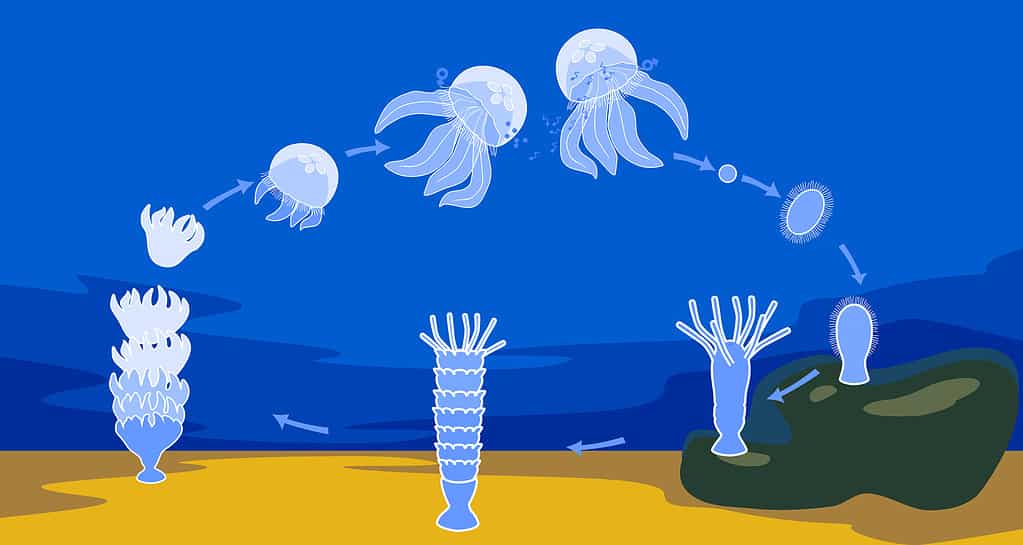
©mariaflaya/iStock via Getty Images
2. Baby Jellyfish Do Not Have Stinging Tentacles Like Adult Jellyfish Do
An ephyra, or larval jellyfish, does not have a closed umbrella-shaped bell as adult jellyfish do. Nor do they have stinging tentacles. A baby jellyfish’s bell consists of underdeveloped lobes. Baby jellyfish may seem fragile, but they are well adapted to swim, feed, and grow into mature adult jellyfish. As the baby jellyfish develops and matures, it starts to grow short, stumpy tentacles, which then lengthen and become non-transparent at a later stage. As the baby jellyfish grows, its bell starts to adopt the characteristic shape of the medusa form, their oral arms will develop, and they will slowly start to resemble the adult jellyfish.
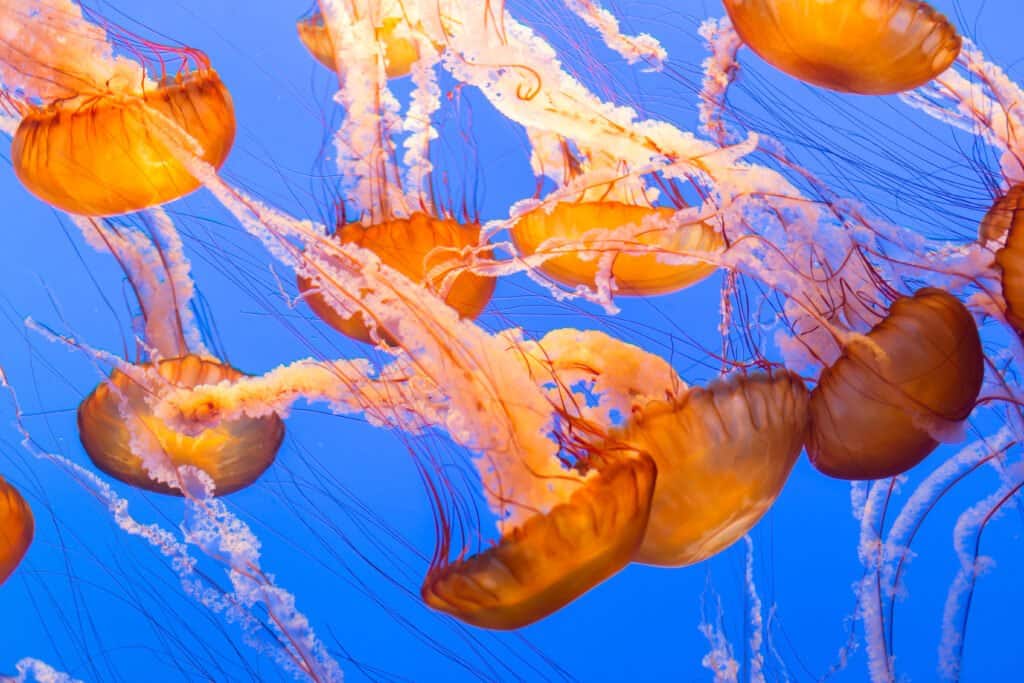
©Ken Wolter/Shutterstock.com
3. Baby Jellyfish Are Tiny
Baby jellyfish are tiny when they bud off from the polyp. At this stage, their bell will be no more than a few millimeters or less than one-eighth of an inch in diameter. They start to grow as soon as they swim away and start to feed. Most mature adult jellyfish’s bells range from less than half an inch to about sixteen inches in diameter. The bell of the lion’s mane jellyfish is, on average, three feet wide; however, some lion’s mane jellyfish’s bells can even grow to over six feet in diameter, with tentacles stretching over a hundred feet.
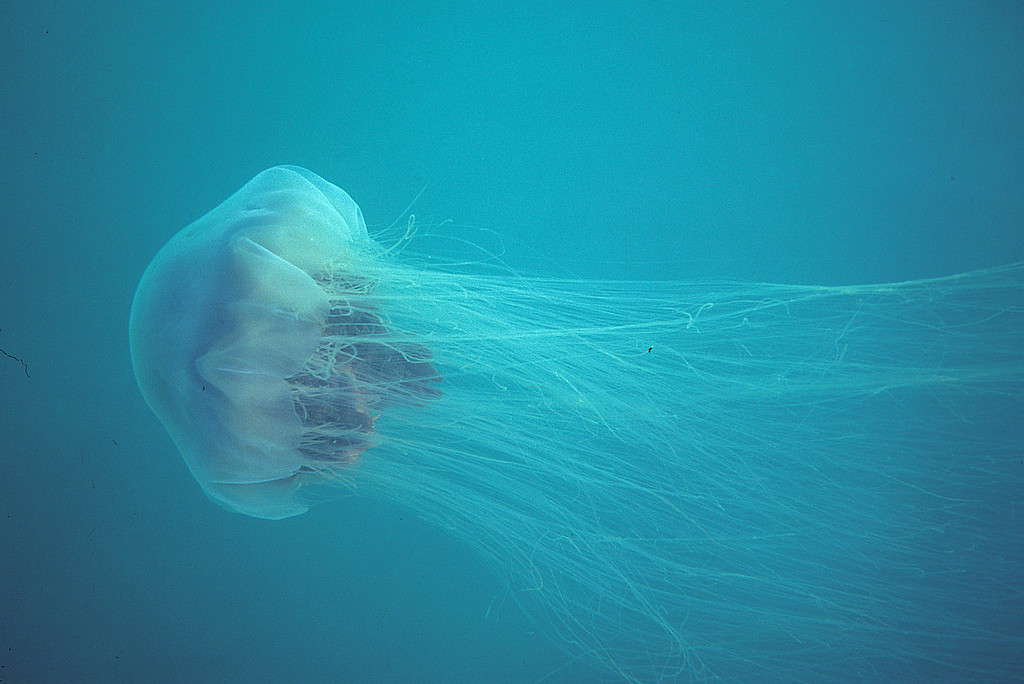
©Derek Keats / CC BY 2.0 – License
4. Baby Jellyfish Eat in a Different Way
The stage of the jellyfish’s life cycle determines the dietary habits of the jellyfish. Therefore, a jellyfish’s diet changes as the jellyfish develops. The jellyfish starts to develop its digestive system during the polyp stage. The jellyfish is sedentary at this point and will eat anything floating past that it can catch with its tentacles. It would usually be zooplankton and phytoplankton. At the ephyra or baby jellyfish stage, the jellyfish can swim freely and start to hunt and target bigger food to eat. They continue doing so into the adult jellyfish stage.
Baby jellyfish are active hunters, just like adult jellyfish, although their size does put limitations on what they are able to eat. They also eat slightly differently than adult jellyfish do. Baby jellyfish use the underdeveloped lobes of their bell to move food toward their mouth. Their mouth is located on their underside and in the center of their bell. The adult jellyfish use their tentacles to stun, paralyze, or kill their prey and use their oral arms to direct their food towards their mouth.
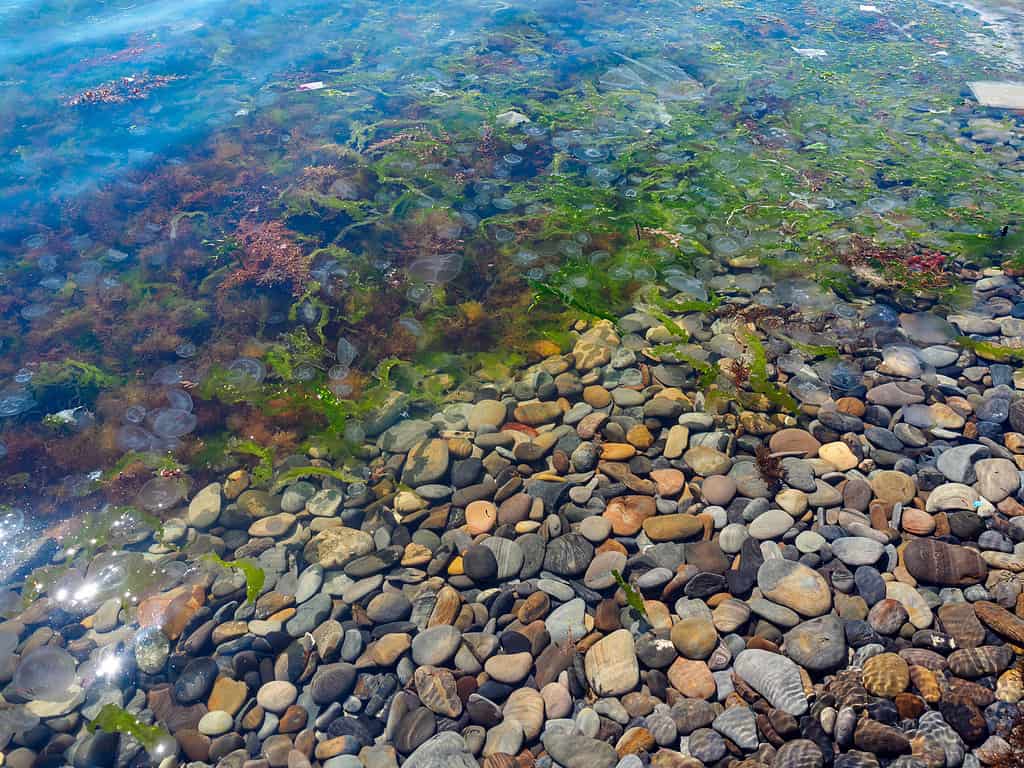
©Yuliya Shauerman/iStock via Getty Images
5. Baby Jellyfish Have a Slightly Different Diet than Adult Jellyfish
Most adult jellyfish feed on copepods, fish larvae, and other small animals caught in their tentacles. However, some do extract minuscule animals and phytoplankton or algae from the water. Baby jellyfish mostly eat zooplankton, including small eggs, small larvae, other ephyra, or small bits of floating fish food, as well as phytoplankton.
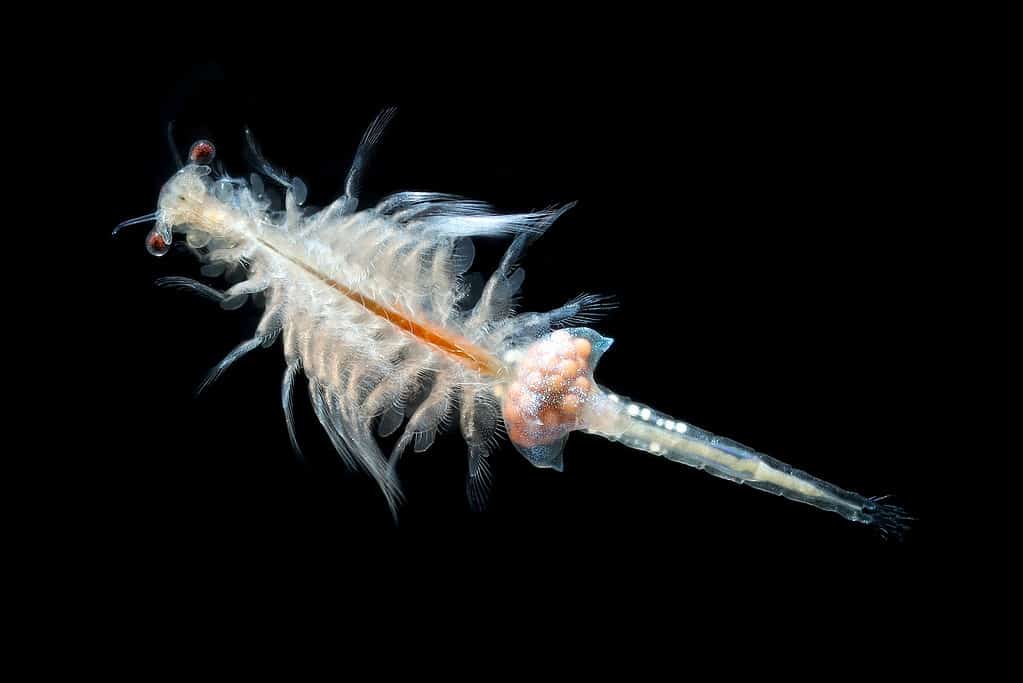
©Dan Olsen/Shutterstock.com
6. Baby Jellyfish Inhabit the Planktonic Range
Baby jellyfish are often near the shore or in shallow waters and sunlit areas, as well as in deep ocean water. Considered to be part of plankton, baby jellyfish are weak swimmers and usually inhabit the planktonic range within the tides and currents of the oceans. Baby jellyfish often just float in the water and drift with the currents. This allows the jellyfish to broaden their reach in the ocean and to ensure that not all the baby jellyfish inhabit the same area. This will also allow the baby jellyfish to reach other possible suitable habits where conditions are favorable and will ensure the success of the jellyfish population if conditions in other areas start to deteriorate.
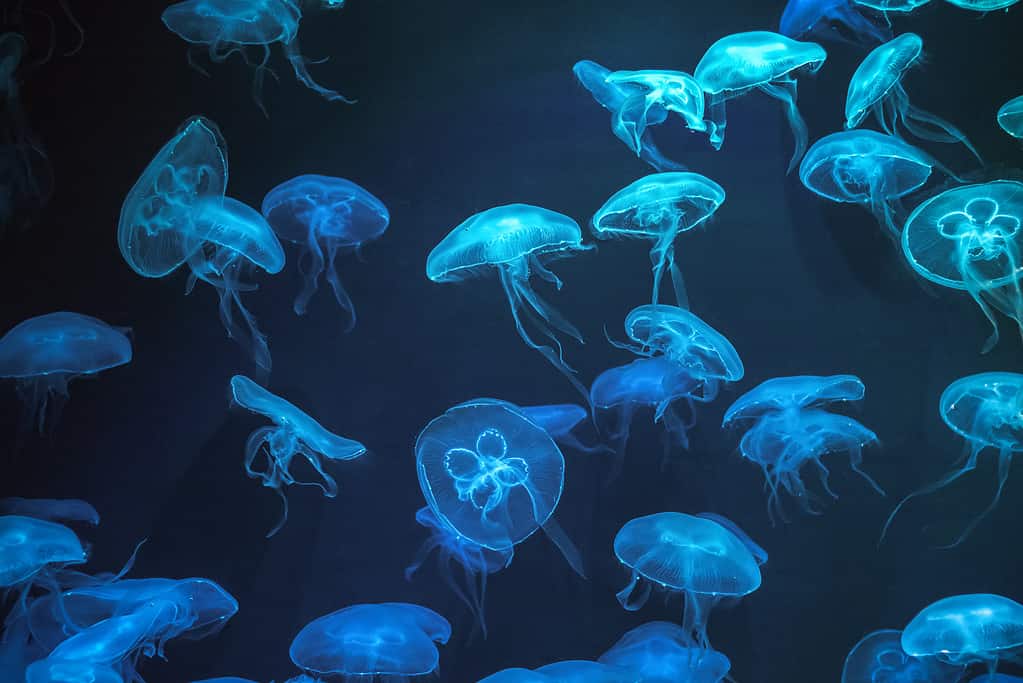
©VictorHuang/iStock via Getty Images
FAQs (Frequently Asked Questions)
Can Baby Jellyfish Bite?
Yes, baby jellyfish bite, and in the process, they can attach themselves to people’s bodies and swimsuits as they swim in the ocean and encounter them. Born during the breeding summer season, baby jellyfish are commonly referred to as “sea lice.” Baby jellyfish are often in large swarms or “blooms.”
Can Baby Jellyfish Sting?
Yes, baby jellyfish can sting, especially when trapped in a swimsuit. Baby jellyfish are not easy to see and are tiny. They can easily pass through the fabric of clothing, get trapped, and start stinging.
How Does a Baby Jellyfish Sting?
A baby jellyfish stings when the baby jellyfish’s nematocysts get stimulated. This happens when the baby jellyfish’s position changes or when there is a change in the salt content of the baby jellyfish’s surroundings. A springlike mechanism in the tentacles of the baby jellyfish will then project a barbed spear and shoot venom into the target, such as a person’s skin.
Does a Baby Jellyfish Sting Hurt?
A baby jellyfish sting doesn’t hurt like an adult jellyfish sting does. A rash or skin irritation on your body usually indicates a baby jellyfish sting. This often occurs in the most sensitive parts of the body. The rash usually starts to show in twenty-four hours. Other symptoms can also accompany the rash. These symptoms often include chills, fever, headaches, and nausea. The rash oftentimes becomes swollen, with raised bumps and pustules. The raised bumps can be quite red and extremely uncomfortable, as they can be very itchy.
How Long Does a Baby Jellyfish Sting Last?
The symptoms are often mild and usually ease for most people in a couple of hours. However, for some, it could take a couple of days or even a couple of weeks. Some cases can be quite severe and associated with flu-like symptoms that can last for a long time and need medical attention to manage them. Children, as well as people with allergies or who have a weakened immune system, are especially at risk of reacting badly to a baby jellyfish sting.
What Can I Do When a Baby Jellyfish Stings Me?
Applying vinegar to the area might help to inactivate some of the poisons and toxins in the nematocysts. Do this for thirty seconds at a time. If vinegar is unavailable, then use seawater. Avoid washing the area with fresh water; rather, use warm salt water. And avoid rubbing or scrubbing the area. An over-the-counter anti-itch ointment or anti-inflammatory cream may be helpful; however, seek medical assistance if symptoms persist or worsen.
What Can I Do to Avoid a Baby Jellyfish Sting?
You can minimize the risk by removing your swimsuit and showering after getting out of the ocean. However, the baby jellyfish can become trapped in the fabric of the swimsuit. Therefore, it is advised to rinse the swimsuit in household vinegar or rubbing alcohol before washing the swimsuit and reusing it. You can also choose to wear a T-shirt with a slight neckline over your swimsuit.









